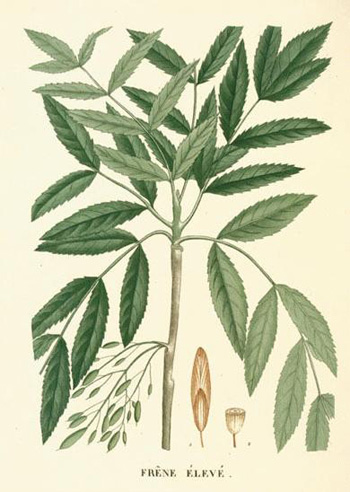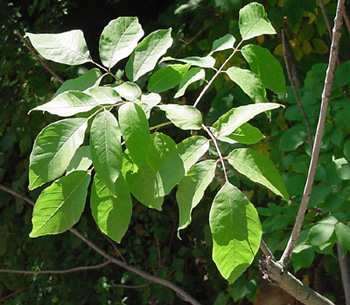Contents:
Common Names | Parts Usually Used | Plant(s) & Culture | Where Found | Medicinal Properties
Legends, Myths and Stories | Uses | Formulas or Dosages | Bibliography
Scientific Names

- Fraxinus excelsior L.
- Oleaceae
- Olive family
Common Names
- American white ash
- European ash
- Weeping ash
Parts Usually Used
Bark, leaves
Back to Top
Description of Plant(s) and Culture

Bird’s tongue is a European tree,
Another variety: American ash
Back to Top
Where Found
Commonly planted in parks and along streets and found wild in woods and along riverbanks and streams. North America, Europe, Asia and extending south into Mexico and Java.
Back to Top
Medicinal Properties
Bark: diuretic, febrifuge, stimulant, laxative
Leaves: cathartic
Back to Top
Legends, Myths and Stories
The ash was a sacred tree of Scandinavian and Germanic tribes of northern Europe. According to their mythology a mighty ash tree, called Yggdrasill, served as a representative of the cosmos. The tree’s roots were the underworld, the earth or Midgard (meaning middle ground) was where the people lived, a disk surrounded by a ring of water. This disk and its circular ocean covered the tree’s lower branches, supported by the trunk. In the upper branches, Valhalla, the heaven of the gods, was located, along with the land of the giants and the land of the frozen north.
According to this same mythology, the universe, the gods, and the giants came into being first. After that, vegetation sprouted forth; then the gods created the first human couple out of two trees. The first man, who was called Ask, sprang from an ash tree; and the woman, Embla, was thought to have come from the elm or alder tree. The name ash is derived from Ask.
Pliny thought that the ash tree repelled snakes. According to him, if a snake had the choice of entering a ring of fire or going near the ash tree, the snake would jump into the fire.
Back to Top
Uses
The bark is used to reduce fever, ague, and expel intestinal worms. The leaf tea (popular in Europe) is used as a purgative and for rheumatism, gout, arthritis, dropsy.
The old herbalists thought that
Back to Top
Formulas or Dosages
Use the bark of young branches and twigs.
Infusion: use
Decoction: use
Back to Top
Bibliography
![]() American Folk Medicine
American Folk Medicine, by Clarence Meyer, Meyerbooks, publisher, PO Box 427, Glenwood, Illinois 60425, 1973
![]() Culpeper’s Complete Herbal & English Physician: Updated With 117 Modern Herbs
Culpeper’s Complete Herbal & English Physician: Updated With 117 Modern Herbs, by Nicholas Culpeper, Meyerbooks, publisher, PO Box 427, Glenwood, Illinois 60425, 1990, (reprint of 1814)
![]() Eastern/Central Medicinal Plants
Eastern/Central Medicinal Plants, by Steven Foster and James A. Duke., Houghton Mifflin Company, 215 Park Avenue South, New York, NY 10000
Herbal Recipes, by David C. Meyer, Meyerbooks, publisher, PO Box 427, Glenwood, Illinois 60425, copyright 1978, seventh printing, August 1996
![]() The Herbalist Almanac
The Herbalist Almanac, by Clarence Meyer, Meyerbooks, publisher, PO Box 427, Glenwood, Illinois 60425, copyright 1988, fifth printing, 1994
![]() The Herb Book
The Herb Book, by John Lust, Bantam Books, 666 Fifth Avenue, New York, NY. copyright 1974.
 How Indians Use Wild Plants for Food, Medicine & Crafts
How Indians Use Wild Plants for Food, Medicine & Crafts, by Frances Densmore, Dover Publications, Inc., 180 Varick Street, New York, NY 10014, first printed by the United States Government Printing Office, Washington, in 1928, this Dover edition 1974
![]() Indian Herbalogy of North America
Indian Herbalogy of North America, by Alma R. Hutchens, Shambala Publications, Inc., Horticultural Hall, 300 Massachusetts Avenue, Boston, Massachusetts 02115, 1973
![]() Indian Uses of Native Plants
Indian Uses of Native Plants, by Edith Van Allen Murphey, Meyerbooks, publisher, PO Box 427, Glenwood, Illinois 60425, copyright 1958, print 1990
![]() Webster’s New World Dictionary
Webster’s New World Dictionary, Third College Edition, Victoria Neufeldt, Editor in Chief, New World Dictionaries: A Division of Simon & Schuster, Inc., 15 Columbus Circle, New York, NY 10023
 The Rodale Herb Book: How to Use, Grow, and Buy Nature’s Miracle Plants (An Organic gardening and farming book)
The Rodale Herb Book: How to Use, Grow, and Buy Nature’s Miracle Plants (An Organic gardening and farming book), edited by William H. Hylton, Rodale Press, Inc. Emmaus, PA, 18049., 1974
